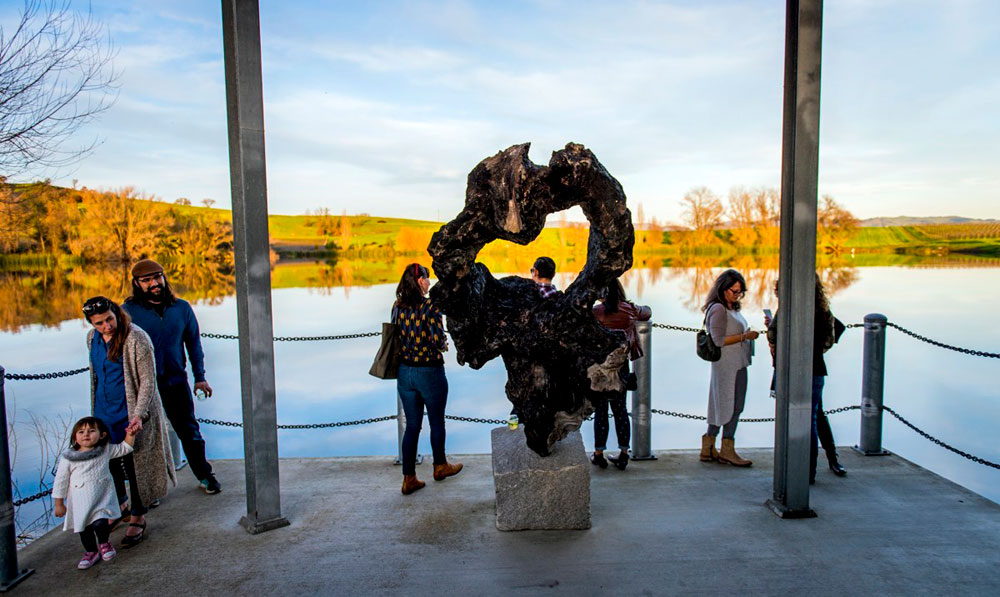
August 20, 2019; San Francisco Chronicle
The board of the di Rosa Center for Contemporary Art, located in Napa, California, has made a big decision, and in the process angered a number of artists. Specifically, the board of the Rene and Veronica di Rosa Foundation, has decided to sell the bulk of its collection. The board says that its budget cannot support the costs of caring for the collection. In a letter reprinted in the Chronicle, director Robert Sain writes that the museum intends to use revenues from deaccessioning to “grow the endowment to provide a sustainable future of the organization, including the proper care of the arts that will remain in the collection, which has now, at great expense, been safely housed in climate controlled storage.” The alternative, Sain claims, is to “close our doors forever.”
But many in the arts community are unpersuaded by such explanations. Nearly 150 artists, galleries, and other art world stakeholders have signed a letter communicating their opposition to the sale of art works. They claim the di Rosa collection is “the only collection in the world dedicated exclusively to the history of post-World War II art in Northern California in all its diversity of media, gender, race, and philosophy.”
The di Rosa museum does not actively collect work anymore; it contains about 1,600 works collected by Rene and Veronica di Rosa before Rene’s death in 2010. The mission stated on its Form 990 calls the collection “the most significant holding of [San Francisco] Bay Area art in the world.”
However, says Sain, the budget is just not enough. “The reality is the organization has just always been underfunded,” he told the San Francisco Chronicle.
The organization’s forms 990 show that even though fundraising has increased from 2010 to 2017 (the most recent 990 available), it has indeed run a deficit most of those years. They raised about $575,000 in 2010 and $1.9 million in 2017, but still ran a deficit of about $50,000 that year. The amount spent on salaries during that time has about doubled, including raising the executive director’s salary from $125,000 to $192,500 last year.
Brenda Mixson, president of the foundation’s board of directors, said in a statement, “The decision to reduce and focus the collection is necessary to keep di Rosa Center for Contemporary Art’s doors open and to allow both organizations to thrive and serve our community. As non-collecting entities, our emphasis will be on commissioning and supporting working artists and expanding the artistic experiences available for visitors.”
But the letter signed by the artists claims, “Rene di Rosa wanted the collection preserved as a whole above all other institutional concerns.”
Sign up for our free newsletters
Subscribe to NPQ's newsletters to have our top stories delivered directly to your inbox.
By signing up, you agree to our privacy policy and terms of use, and to receive messages from NPQ and our partners.
NPQ readers will remember that in 2018 the Berkshire Museum employed a similar tactic, selling off 22 artworks to raise money for a self-reinvention. The sale generated $53.25 million, and though whether that revenue will be wisely spent remains to be seen, the museum earned a sanction from the Association of Art Museum Directors, who said, “Selling art to support any need other than to build a museum’s collection fundamentally undermines the critically important relationships between museums, donors, and the public. When museums violate the trust of their donors and the public, they diminish the opportunity and responsibility to make great works of art available to the public.”
The museum association does not appear to have weighed in yet on di Rosa’s decision. As NPQ has noted before, selling donated art works is only legally permissible if it maintains “as near as practicable” (cy pres) the intent of the donor. For his part, Sain claims to be honoring donor intent, but of course a court might deem otherwise.
One difference that might be relevant is that unlike the Berkshires, the Bay Area has the highest density of billionaires per capita of any metropolitan area in the world. It also houses a number of foundations. Could a concerted effort by the board and the local arts community be able to tap into that wealth save the collection?
In an odd twist of fate, the board is being advised on sale preparations by Graham Beal, former director of the Detroit Institute of Arts. Beal is famous in the art world for physically reinventing his museum, getting rid of the “fusty” halls through which visitors would do what he called “the museum glide.” It’s now an inviting, engaging, community-oriented space.
He’s more famous in the world at large for striking what’s known as the “Grand Bargain.” When Detroit declared bankruptcy, a state-appointed emergency manager wanted to sell off priceless works from DIA’s collection to retire some of the city’s debt. Beal hammered out a deal to raise millage from neighboring counties and $100 million from donors, and saved the art. He told the Detroit Free Press, “I will have to be dismissed before any art is taken.”
Nevertheless, he and the di Rosa board have determined to offload a large portion of di Rosa’s collection. It will fundamentally change the identity and mission of the organization and may break up a collection that uniquely represents a key time and place in art history. But without more institutional support, all the letter has so far is a growing list of concerned artists.—Erin Rubin
Correction: This article has been altered from its initial form to reflect clarification as to the salary of the executive director position. Kathryn Reasoner, the prior director, informs us via email, “The drop in executive pay reported on tax documents was due to the drop in expense following my resignation, when the Board worked with an interim director as part of a planned transition.” Nonprofit Quarterly apologizes and wishes to correct the error.











